QuestionQUESTION: I bought a 20month old female Pot Belly Pig on 16/10/2010. We call her Tinkerbelle. She is grossly overweight (can't see where face and bum is from the side) and her hooves are grossly overgrown (+- 10cm long). She was fed dog food mixed with whole mealies. She's not eating (last ate half a grated carrot on the day she arrived) now she just gets upset when you try to feed her. She doesn't walk much, her feet seem sore (limping in front, hooves curling outwards). She is drinking water and wading. How can I help my new baby. Weight wise, appetite wise and foot wise? I do horses hooves but not sure how much to take off at a time. Can't find Pot Belly food here, is 12% horsemeal ok? (Queenstown, South Africa)or should I stick to bran mixed with fresh vegies? How long after a move do they start eating? Your assistance will be much appreciated. Thank you. I am really stressed and worried about "Tinky" (This is the shape she's in too). Send me an e-mail for a photo please.
ANSWER: Tinkerbelle is very lucky you bought her and took her home with you!
Tinkerbelle is probably fat blind and possibly deaf, as well. Unable to see and hear, and barely able to move, she's been taken from a familiar environment and put in a strange, new place, with strange, new people. It may take a few weeks for her to adjust.
The important thing is that she is drinking so she stays hydrated, and also that she is going potty. Try offering her all sorts of different things, and when you find something she is willing to eat, put some of that on her regular pellets. Pigs often like dairy products like milk, sour cream, ice cream, yogurt, etc. No need to put a lot on her pellets, just enough to get her to eat, and gradually reduce that amount over a few weeks.
The 12% horse feed is fine. Supplement this with fresh veggies, like celery and lettuce. These are high in liquid so she stays hydrated, high in fiber to help her digestive system, high in nutrients to help her feel good while she looses weight, and crunchy so she can really enjoy eating. Some pigs prefer soaked food, so try soaking her pellets with warm water, and stirring in a little bit of milk or sour cream.
It's Ok to cut the hoof back quite far. Pig hoofs are just cuticle. A blood vein may grow down into very long hooves, but it will retreat back as her hooves are kept short. Some websites with piggy hoof care info are farec.org and pigs4ever.com Also, the yahoo groups Potspot and PigInfoAndChat have lots of good info in the files section, and lots of experienced, friendly people who welcome questions.
If you can get Tinkerbelle down for a belly rub, try wiping out her eyes with a soft, warm, damp cloth. Also wash the ears but be very careful. Pigs have narrow ear canals, and if there's lots of gunk around it's easy to accidentally push some gunk in while cleaning the rest out. Don't flush her ears with water.
Once you've got her eating she may develop diarrhea or constipation. For diarrhea, give her a little yogurt with probiotics. For constipation, give her canned pumpkin or squash.
When she's eating and going potty regularly and her hooves are trimmed, it's time to get her on an exercise program. Scatter a handful of plain, air popped popcorn around, and let her walk to retrieve each piece. She may or may not be able to play with a Busy Ball, that is, any ball or old carton with holes punched in it. Put in some plain, air popped corn, and let her roll it around. The holes should be big enough for the popped corn to fall out as the carton is rolled around.
Keep cleaning her eyes and ears as she looses weight.
---------- FOLLOW-UP ----------
QUESTION: Hello again. Last night (19.10.2010) Tinkerbelle was able to open her eyes! I tried to feed her yesterday morning but she still wouldn't eat. Last night I tried the horsemeal. SUCCESS!!!!!!!!! I am now just not sure how much horsemeal to feed her. And just exactly how quickly do these "little critters" lose weight? She also seems to be warming up to me a little. :-) The other thing I need to know is, how cold is too cold for Tinkerbelle, and how hot is too hot for her? I know these probably seem to be stupid questions, but we had a chilly night out last night (She does not live inside yet) and I was worried that she might be cold seeing as she doesn't want to sleep on her sleepingbag. She slept under the creeping rose bush where she made a nest for herself. (She didn't have a mudpool, kennel or water pool where we got her from, so i dont think she knows what a blanket is). The first night was quite cool as well and I covered her up with a duvet, which she ended up ontop of. So I a put the sleeping bag over her. Next morning she had burrowed into them but was lying ontop again. I also just want to make sure when I should take extra precautions to prevent her from feeling uncomfortable and lessen any stress there might be due to climate. Thank you so much for your help. From my side and Tinky's. Kindest Regards - Althea
AnswerPigs can tolerate a wide range of temperatures as long as they are used to the temperature. Sudden, dramatic temperature changes can hurt a pig, such as taking a pig from a hot, sub-tropical climate directly to a cold, snowy place, or vice versa.
Pigs do just fine with temps below freezing IF they have dry, windproof shelter. The key words are dry and windproof. Wet bedding sucks heat away from the body. Wind can blow all the heat out of a drafty place. They can also tolerate hot, humid climates as long as they have shade and water and can rest in the hottest part of the day. Mud puddles also help a lot, a thick coat of mud helps the pig stay cool.
For outdoor pigs, straw is a much better bedding than blankets. Dew or moisture from the ground will make a blanket damp and not very warm. A thick layer of straw can tolerate the moisture and still provide warmth.
Feeding pigs is more of an art than a science. So much depends on the kind of food and how active the pig is.
I'd give her no less than 1 cup of food per day, supplemented with another cup of fresh veggies, and 1 cup of plain rolled oats, and divided into two meals. As her weight begins to drop and her activity level increases, I'd increase the amount of feed, while decreasing the amount of oats. The rule of thumb for feeding pigs is 1 cup of pig food per 50 lb of pig, but horse food is higher in fiber and less dense nutritionally, so she might need more horse food than pig food.
Grossly obese pigs loose quickly at first just because there is so much excess weight, it just melts off as they start to move. When they get down to the plain obese stage, the rate of weight loss may slow a little.
You should see some signs of change in a couple of weeks. Maybe just a bit less puffiness around the face or just a softer, less "stuffed sausage" look. After a month you should see some very clear and obvious signs of weight loss.

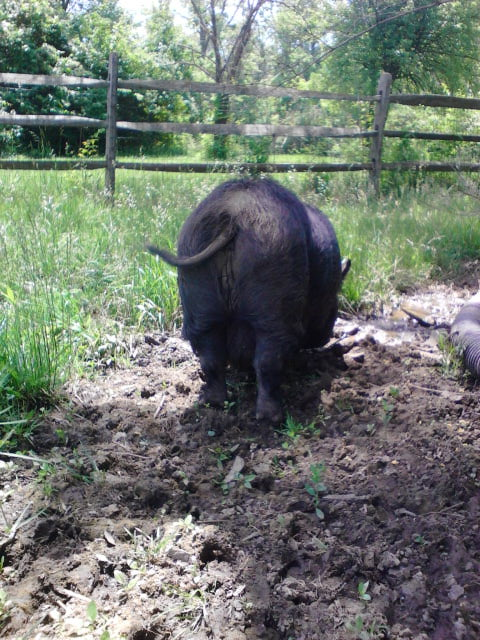 2 pot belly pigs male/female? abandoned & need a home
Question
mama? both pigs
Hello, thank you
2 pot belly pigs male/female? abandoned & need a home
Question
mama? both pigs
Hello, thank you
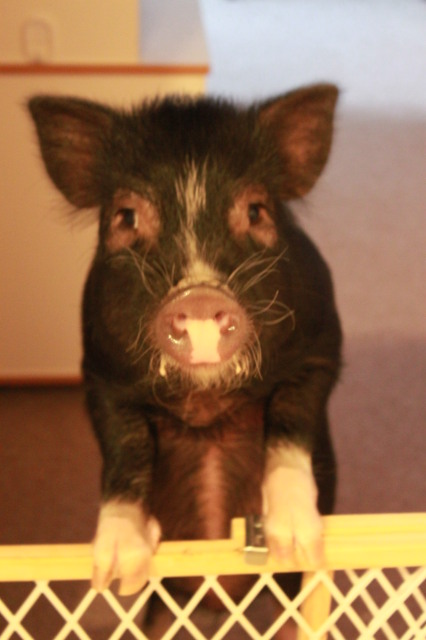 Mischievous piggy
Question
Hoover
I am the proud owner of a 9 month old n
Mischievous piggy
Question
Hoover
I am the proud owner of a 9 month old n
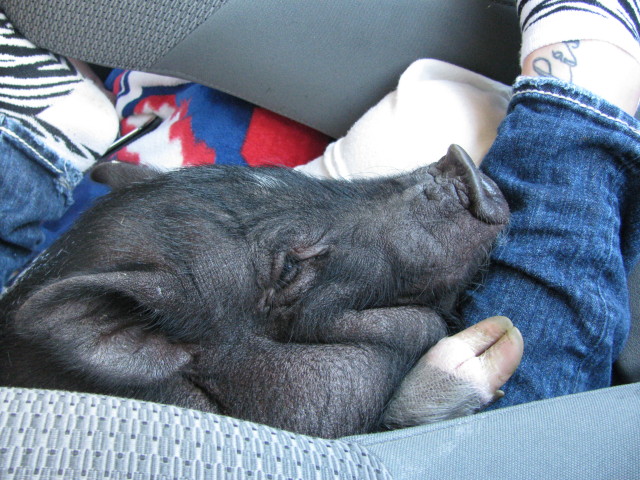 Pooping and Pottying inside
Question
JJ
Hello, We adopted a 10 month old PBP in Aug
Pooping and Pottying inside
Question
JJ
Hello, We adopted a 10 month old PBP in Aug
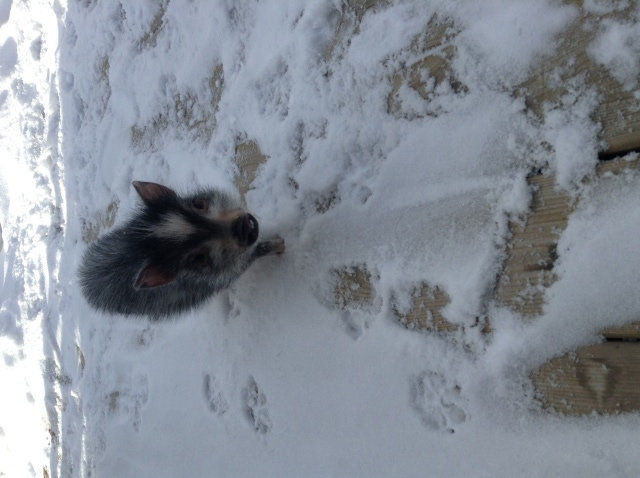 Piggy attitude
QuestionQUESTION: Hi,
I have a 6 month old micro mini j
Piggy attitude
QuestionQUESTION: Hi,
I have a 6 month old micro mini j
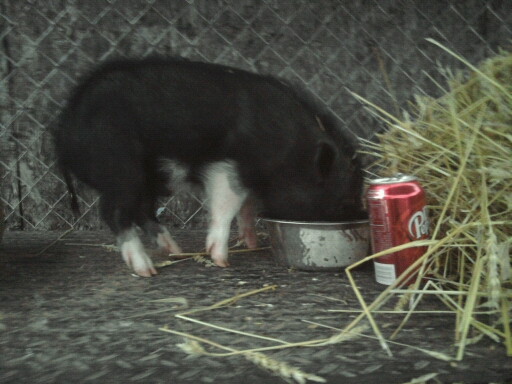 How big will he get?
Question
Carter
I have a six month old potbellie
How big will he get?
Question
Carter
I have a six month old potbellie